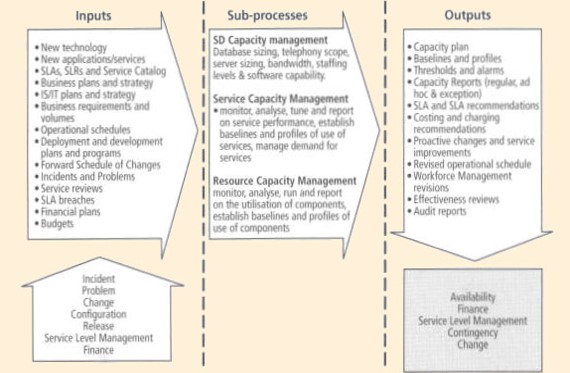
There are a number of sources of information that are relevant to the Capacity Management process. Some of these are as follows:
- External suppliers of new technology
- The organisations business strategy and plans, and financial plans
- The IT strategy and plans and current budgets
- The Incident and Problem Management processes with incidents and problems relating to poor performance
- The SLM process with details of the contents of the SLAs and SLRs, and possibly from the monitoring of SLAs, service reviews and breaches of the SLAs
- The Change Management process with a forward Schedule of Changes and a need to assess all Changes for their impact on the capacity of the infrastructure
- The IT Operations team with schedules of all the work that needs to be burn and information on the dependencies between different services, and the interdependencies within a service.

The image above shows the inputs to, the sub-processes within and the outputs from the Capacity Management process.
The sub-process
Capacity Management consists of a number of sub-processes, of which there are various activities. The sub-processes of Capacity Management are:
Business Capacity Management: This sub-process is responsible for ensuring that the future business requirements for IT Services are considered, planned and implemented in a timely fashion. This can be achieved by using the existing data on the current resource utilization by the various services to trend, forecast or model the future requirements. These future requirements come from business plan outlining new services, improvements, and growth in existing services, development plans etc.
Service Capacity Management: The focus of this sub-process is the management of the performance of the live, operational IT Services used by the Customers. It is responsible for ensuring that the performance of all services, as detailed in the targets in the SLAs and SLRs, is monitored and measured and that the collected data is recorded, analyzed and reported. As necessary, the action is taken to ensure that the performance of the services meets the business requirements. This is performed by staff with knowledge of all the areas of technology used in the delivery of end-to-end service and often involves seeking advice from the specialist involved in Resource Capacity Management.
Resource Capacity Management: The focus of this sub-process is the management of the individual components of the IT Infrastructure. It is responsible for ensuring that all components within the IT Infrastructure that have finite resource are monitored and measured and that the collected data is recorded, analyzed and reported. As necessary, action must be taken to manage the available resource to ensure that the IT Services that it supports to meet the business requirements. In carrying out this work, the Capacity Management process is assisted by individuals with specialist knowledge in particular areas of technology.
The activities that are carried out by the sub-processes. Each of the subprocesses carries out many of the same activities, but each sub-process has a very different focus. Business Capacity Management is focused on the current and future business requirements, while Service Capacity Management is focused on the delivery of the existing services that support the business and Resource Capacity Management is focused on the technology that underpins all the service provision.
